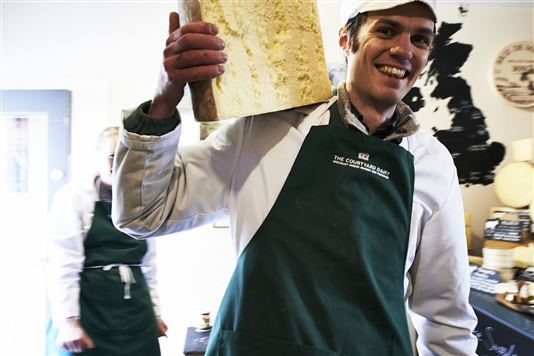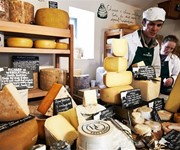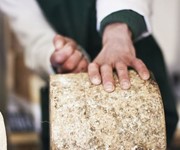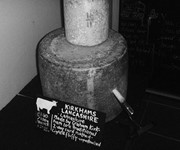A day in the life of a top cheesemonger

Hailed ‘Cheesemonger of the year’ at this year’s World Cheese Awards, Andy Swinscoe of The Courtyard Dairy tells us all about his day.
A chilly business
 First off, I know that I am going to spend the whole day in a very cold shop. And I don’t know when, or even if, I’ll get lunch. This means steaming porridge and piping hot tea is an essential way to start my day, and I make sure I’m well wrapped up – I wear thermals for six months of the year!
First off, I know that I am going to spend the whole day in a very cold shop. And I don’t know when, or even if, I’ll get lunch. This means steaming porridge and piping hot tea is an essential way to start my day, and I make sure I’m well wrapped up – I wear thermals for six months of the year!
A short drive from home, and I arrive at The Courtyard Dairy, my small shop in part of a converted ancient barn complex just off the A65 near Settle, North Yorkshire.
The shop itself is a bit like a cellar: it’s cool (we chill it down to 12°C to mature the cheese), its walls are a metre thick and there is only one tiny window. There’s cheese everywhere, stacked high on shelves to the roof. The first job of the day is to remove the covers on the cheeses (each night the cheese shelves are covered and wet towels hung up to keep a high humidity).
Brush, wash, oil or flip?
Then, before any customers arrive, I check the condition of each cheese. This involves giving the cheese the care and ageing assistance they need. Some may need brushing, others washing, turning, oiling and flipping. I pride myself on the quality of the cheeses I look after and sell, and this is reflected in the care I take when looking after them. Each one is touched, assessed and dealt with on an individual basis. There is no point selecting the absolute best cheeses from the farm, only to let them deteriorate in the shop.
By 9.30am I’ve finished caring for the cheeses, and the doors are opened for the crowds to flock in...
Well, actually they don’t. Being in an out-of-town location, the busy period for The Courtyard Dairy is actually from 11am onwards. This gives me time to cut and prepare cheese for the mail orders that come in overnight (I send cheese all over the UK), and the wholesale orders for local restaurants.
No cheese is the same
 Each cheese is kept as whole as possible, with the pieces sold being cut-to-order. The fun bit comes when we’ve sold all of one cheese, and it’s time to break into an uncut one. Most of the cheeses are cloth-bound and have a natural rind (unlike the vac-packed commercial varieties) which, along with their farmhouse nature and the fact that many are made from unpasteurised milk, means that each batch is different and matures at a different rate. This also means the next whole cheese may taste different from the last one. I often demonstrate the natural differences to customers by doing a tasting of two batches of Cheddar from the same producer and the same week of production.
Each cheese is kept as whole as possible, with the pieces sold being cut-to-order. The fun bit comes when we’ve sold all of one cheese, and it’s time to break into an uncut one. Most of the cheeses are cloth-bound and have a natural rind (unlike the vac-packed commercial varieties) which, along with their farmhouse nature and the fact that many are made from unpasteurised milk, means that each batch is different and matures at a different rate. This also means the next whole cheese may taste different from the last one. I often demonstrate the natural differences to customers by doing a tasting of two batches of Cheddar from the same producer and the same week of production.
So before I cut into a new cheese it must be tested. Grabbing my notes (detailed notes are kept on each cheese batch), I ‘iron’ those cheeses that my experience tells me are coming to perfect maturity. This involves using a ‘cheese iron’, which allows a plug (or bore) to be removed from the cheese so I can assess its maturity. From a small sample taken from the end of the plug I can assess the appearance, texture, smell, and taste, before I refit the plug back into the cheese so it can continue to mature.
Once I’ve chosen which cheese to sell next, the selected one will then be ‘broken down’. This involves stripping off the cloth binding and cutting the cheese into attractive pieces of manageable size to allow 250g portions to be easily cut from them.
The cheese experience
With the cheeses ready, the mail orders dispatched and the wholesale orders sent off in the van, the customers start to trickle in, gradually at first, but soon building up to a crescendo! I like to offer my customers an all-round experience in the shop. Everyone who comes through the door is offered at least a couple of tastes of cheese, and receives an interesting (to most!) background to the cheese they are tasting: where it has come from, the producer, why I chose it. I like to visit every cheese producer I buy from, often helping to make the cheese, so I can learn the background and their production process.
In turn, I like to pass this knowledge onto my customers, so that the shop is more of a ‘cheese experience’ for them, where they can learn about the small producers I work with, rather than just be another place to buy cheese.
Explanations are offered, and stories of the farmers are told, as the customer tastes through a nicely-balanced selection of cheeses. It’s very rare that someone leaves without taking a piece of one or more of the cheeses they’ve tasted: normally the next stage is cutting, wrapping and sealing. Then they depart, with their little bit of heaven tucked into a Courtyard Dairy carrier bag.
Always time for a cuppa
 If I get time, I enjoy a cup of tea and lunch (usually a warm soup) – anything to help me keep warm. I avoid cheese sandwiches! But that’s because I do eat a lot of cheese: each time I give a customer a taster I like to check the quality for myself (at least, that’s my excuse!).
If I get time, I enjoy a cup of tea and lunch (usually a warm soup) – anything to help me keep warm. I avoid cheese sandwiches! But that’s because I do eat a lot of cheese: each time I give a customer a taster I like to check the quality for myself (at least, that’s my excuse!).
Finally, it’s 5.30pm, and nearing home time. The cheeses are wrapped, sealed and put to bed (covered with the cloths). The counters, cheese wires, implements and floor are thoroughly cleaned. The takings are locked away. The alarm is set. Then it’s a short drive home to check the mail and wholesale orders that have come in for delivery tomorrow (there’s no space for a computer in the shop).
Then it's time to thaw out by a nice log fire...
You might also like
Top five best cheese shops in the UK
Comments
Be the first to comment
Do you want to comment on this article? You need to be signed in for this feature